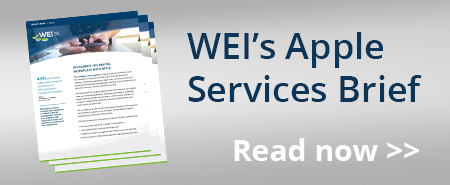The best enterprise leaders know that the key to improving employee productivity and efficiency is making it as easy as possible for their staff to do their jobs. When it comes to IT, that means offering the best user experience with consistent performance and ensuring the resources users need are always available.
For many enterprises, Apple devices have become the next step forward in offering employees the user experience they want. However, the implementation and administration of Mac™, iPad™, iPhone™, and other Apple® devices have created unique challenges for many IT organizations that were unfamiliar with the Apple provisioning model. As part of our commitment to helping enterprises start their Apple journey on the right foot, we’ve compiled the top 5 most frequently asked questions we receive about deploying Apple in the enterprise and our answers.
1. Are Apple Devices Secure Enough?
Security is often top of mind whenever new technology is being introduced at the enterprise, and for good reason. Thankfully, Apple takes security and protecting corporate data seriously, with advanced security built into every product from the ground up.
From system security, to data security, to app security, Apple has gone to great lengths to ensure the use of Apple in the workplace does not pose a security risk.
Here are a few of the strategies and technologies utilized by Apple to ensure security:
- Secure startup processes
- Extensive system safeguards
- Strong passcode policies
- The Apple T2 Security Chip
- Runtime protection, sandboxing, and other tools used to ensure downloaded apps are only accessing data in pre-authorized ways
In fact, Apple is emerging as an industry leader when it comes to user data privacy and security and has taken a firm stance on data protection as a corporation. In case you missed it, you can watch Apple CEO Tim Cook’s 12-minute opening keynote presented at the most recent Computers, Privacy & Data Protection (CPDP) Conference.
[Featured video]
Real Tech with WEI Customer Question video series
Misconceptions of Apple in the Enterprise

2. Is Implementation More Complex?
Once the decision has been made to begin offering an Apple as a Choice program to employees, the next step is to plan for implementation. To make the process of rolling out Apple in the enterprise as simple as possible, we can break down the process into four steps:
- Preparation – This phase includes planning for integration with your network and other key infrastructure, as well as setting up any other systems that are required for deployment.
- Set Up – In this step, enterprises define corporate policies for data management and security, as well as setting up your mobile device management (MDM) solution.
- Deployment – Once preparation and set up are complete, enterprises can begin deployment and distribution of Apple throughout the workforce.
- Management – The final step of the process is ongoing management and maintenance of devices, which is made easier through the selected MDM and by partnering with an Apple Authorized Reseller, like WEI.
To guide enterprises through the process of implementation, Apple has created a Mac Deployment Overview, which goes into detail on each of the above steps.
3. How Do Apple Devices Compare When it Comes to Administration?
Ensuring your team is prepared for maintenance and provisioning is vital to successful implementation and administration. Working with an Apple Authorized Reseller like WEI is critical here. We can educate your team on best practices and build them right into your processes. Or you can offload a lot of the administration work to WEI’s team of Apple experts.
While there are third-party alternatives for managing software patches and updates, Apple does offer a cloud-based service called Software Update, which enables IT teams to apply security patches and operating system updates. The service also publishes patches and updates for frequently used applications such as Safari and iTunes for added efficiency. Mac is pointed to the service by default, which automatically notifies end users of any patches and updates they need to apply, and then prompts them to execute the downloads. Putting self-service in the hands of your users keeps them focused and productive and reduces IT support tickets. Which leads us to our next FAQ…
4. Do Apple Devices Complicate the Help Desk?
When it comes to user support, it really is only as complex as you make it. Communication with employees and offering specific instructions to users that make it clear who they need to contact with questions goes a long way to simplifying the help desk experience for both IT and employees.
Another way of simplifying the user experience for those employees using Apple devices is to utilize self-service applications, which can act like an app store where IT can post software that has been tested, an additional browser, or a plugin for their email program, etc. Approved applications like these can be installed to machines automatically with a simple click. Users know the applications are safe to use, and IT does not need to be involved in the installation process.
Plus, there is a good chance an overwhelming majority of your employees have personal familiarity with Apple, from using Mac and iPad at home and doing almost everything else in their life with iPhone. Familiarity with Apple cannot be overlooked and your employees will appreciate using a tool they know and love for work.
5. Can WEI Help Enterprises Get Started?
Absolutely! We are experts in helping enterprises implement Apple, as well as providing ongoing maintenance and support. Our enterprise IT experts will work closely with your team to streamline the deployment of the new Apple technology. We can also show you all the tools available to ease the integration of new devices into your organization, and how to best use them to your advantage. We know the best practices based on our own experience and we’ve been partnering with Apple since 2012. We can help create efficiencies throughout the entire lifecycle: deployment, provisioning, and maintenance. Our customers consider WEI an extension of their team.
[Featured video]
Real Tech with WEI Customer Question video series
How to create efficiencies when managing Apple devices for the enterprise

Ready to Start Offering Apple in YOUR Enterprise?
Offering Apple as a choice to your employees drives productivity, collaboration, and creativity throughout the enterprise. It’s true, and we wrote a whole blog post about it here! Many of our customers have already made the transition to a blended Windows and Apple environment that enables employees to enjoy how they use technology in their jobs. It’s really about providing your employees with the power of choice so they can be happier in their jobs and do their best work. Contact the Apple experts at WEI and we can help you get started and answer any questions you have.
NEXT STEPS: We’re here to help you prepare for Apple in YOUR enterprise. Our eBook below is jam-packed with insights, best practices, and guides to help you prepare your team for Apple. Check out the eBook here and then reach out to our team with your questions. We’re here to offer guidance and support as much as possible as you develop your Apple device management strategy.












